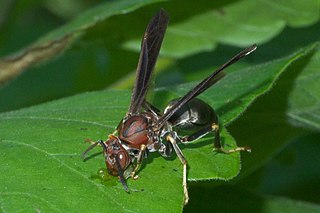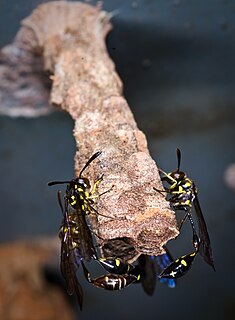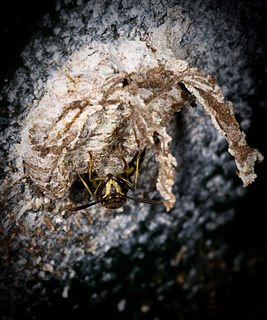
Polistes gallicus is a species of paper wasp found in various parts of Europe, excluding England, Denmark, and Scandinavia, from warmer climates to cooler regions north of the Alps. Nests of these social insects are created in these various conditions. The Polistes species use an oral secretion to construct their nests, which consist of a combination of saliva and chewed plant fibers. This structural mixture physically protects the nest from various harsh elements and from weathering over time.

The Stenogastrinae are a subfamily of social wasps included in the family Vespidae. They are sometimes called hover wasps owing to the particular hovering flight of some species. Their morphology and biology present interesting peculiarities.

Polistes metricus is a wasp native to North America. In the United States, it ranges throughout the southern Midwest, the South, and as far northeast as New York, but has recently been spotted in southwest Ontario. A single female specimen has also been reported from Dryden, Maine. Polistes metricus is dark colored, with yellow tarsi and black tibia. Nests of Polistes metricus can be found attached to the sides of buildings, trees, and shrubbery.

Polistes fuscatus, whose common name is the dark or northern paper wasp, is widely found in eastern North America, from southern Canada through the southern United States. It often nests around human development. However, it greatly prefers areas in which wood is readily available for use as nest material, therefore they are also found near and in woodlands and savannas. P. fuscatus is a social wasp that is part of a complex society based around a single dominant foundress along with other cofoundresses and a dominance hierarchy.

Dufour's gland is an abdominal gland of certain insects, part of the anatomy of the ovipositor or sting apparatus in female members of Apocrita. The diversification of Hymenoptera took place in the Cretaceous and the gland may have developed at about this time as it is present in all three groups of Apocrita, the wasps, bees and ants.
Belonogaster juncea juncea is a subspecies of Belonogaster juncea and is classified as a primitively eusocial wasp, meaning that the species is social while exhibiting a morphology that is indistinguishable from that of other castes. It is also classified as a type of African Paper Wasp. Many of the studies relating specifically to B. j. juncea take place at the University of Yaoundé in Cameroon.

Polistes nimpha is a eusocial paper wasp found all over Europe, with particular sightings in Turkey, Finland, Estonia, and Latvia. It is also found in northern Africa, Pakistan, Iran, India, Kazakhstan, Mongolia, and China. The climate in these areas is relatively cold and snowy in the winter, while summers are usually hot and dry, with steppe vegetation. Polistes nimpha colonies are relatively small and easily manipulated.

Polistes bellicosus is a social paper wasp from the order Hymenoptera typically found within Texas, namely the Houston area. Like other paper wasps, Polistes bellicosus build nests by manipulating exposed fibers into paper to create cells. P. bellicosus often rebuild their nests at least once per colony season due to predation.

Liostenogaster flavolineata is an insect that belongs to the wasp family Vespidae. This hairy-faced hover wasp species is predominantly found in South Asian rain forests, especially in Malaysia. Individual colonies of this species are very small, but aggregations of nests allow for interactions between many smaller colonies. Some worker wasps, known as "helpers", will move between multiple nests in an attempt to improve their position in the dominance hierarchy. Its nests are pale-colored and are usually built with mud. Liostenogaster flavolineata is one of the most studied species in the Stenogastrinae.

Parischnogaster mellyi is a medium-sized species of a hover wasp in the family Vespidae. It is found in Southeast Asia and is widely spread in Thailand and Malaysia. Its nests feature flexible and dynamic qualities, and they are commonly seen under roofs of houses and huts in rural areas. Hovering and patrolling behaviors are the species’ main defining behavioral features, and such activities are closely linked to its mating patterns.

Belonogaster petiolata is a species of primitively eusocial wasp that dwells in southern Africa, in temperate or subhumid climate zones. This wasp species has a strong presence in South Africa and has also been seen in northern Johannesburg. Many colonies can be found in caves. The Sterkfontein Caves in South Africa, for example, contain large populations of B. petiolata.
Ropalidia plebeiana is a eusocial temperate paper wasp. It is unique, as it is the only temperate wasp in the typically tropical Ropalidia genus. R. plebeiana is widely distributed in eastern Australia, and recently have been found making huge nest aggregations, with thousands of nests on trunks of trees, in south-eastern New South Wales.

The Black hover wasp, Parischnogaster alternata, is a eusocial wasp in the genus Parischnogaster. It is native to South-East Asia, and builds its nests in cavities located in dark and damp locations. The nests of Black hover wasps are often found in clusters, which serves as a passive defense mechanism against predators. The annual colony cycle begins with nest initiation by a single foundress though colonies typically consist of 2-3 associative females and helpers that aid in brood development, nest construction, and colony defense. Indicative of the name, female P. alternata are known to strategically hover near nests when visiting other colonies before landing. These intrusions produce responses ranging from aerial fighting to cooperative food sharing.
Protopolybia exigua is a species of vespid wasp found in South America and Southern Brazil. These neotropical wasps, of the tribe Epiponini, form large colonies with multiple queens per colony. P. exigua are small wasps that find nourishment from nectar and prey on arthropods. Their nests are disc-shaped and hang from the undersides of leaves and tree branches. This particular species of wasp can be hard to study because they frequently abandon their nests. P. exigua continuously seek refuge from phorid fly attacks and thus often flee infested nests to build new ones. The wasps' most common predators are ants and the parasitoid phorid flies from the Phoridae family.

Polistes versicolor, also known as the variegated paper wasp or yellow paper wasp, is a subtropical social wasp within Polistes, the most common genus of paper wasp. The most widely distributed South American wasp species, P. versicolor is particularly common in the Southeastern Brazilian states. This social wasp is commonly referred to as the yellow paper wasp due to the distinct yellow bands found on its thorax and abdomen. The P. versicolor nest, made of chewed vegetable fiber, is typically a single, uncovered comb attached to the substratum by a single petiole. The yellow wasp is frequently found in urban areas. New nests and colonies are usually founded by an association of females, sometimes in human buildings. The P. versicolor colony cycle broadly ranges from 3 to 10 months, although there appears to be no relationship between the colony's development and the season of the year. While yellow paper wasps do have clear annual colony cycles, many young queens have the opportunity to hibernate during the winter, forming optional winter aggregations. Dominance hierarchies within these aggregations are characterized by physical aggression of the dominant female(s) towards the associated females, who tend to be sisters. Wagging movements are also often used as a form of communication within the colony. The yellow paper wasp is generally predatory, capturing a wide range of insects, although it often feeds on pollen and nectar as well. Therefore, P. versicolor can be useful as a pollinator or as effective pest control.

Parischnogaster striatula is a species of social hover wasps found in Southeast Asia. Their nests are uniquely shaped, mimic their surroundings and, like the other Stenogastrinae social wasps, lack a nest pedicel. They are also unique in their use of glandular secretion when laying eggs. P. striatula is also different than typical wasps because the queens are not the only ones who possess reproductive capabilities; other females also have developed ovaries. This wasp is also known for fiercely protecting its nest against enemies, such as ants or other hornets.

Liostenogaster vechti is a type of eusocial hover wasp within the family Vespidae. They are typically brown and yellow in color and are considered a passive aggressive species. Their stings are less painful to humans than other social wasps, and they engage in associative nest foundation. They are mostly found on the Malaysian peninsula and are known for living in large clusters of small ring-shaped nests.
Polistes erythrocephalus is a species of paper wasp in the subfamily Polistinae of family Vespidae found in Central and South America. P. erythrocephalus is a eusocial wasp, meaning that it possesses both reproductive and non-reproductive castes. The cooperation between the two castes to raise young demonstrates the altruistic nature of these wasps. P. erythrocephalus exhibits a four-stage colony cycle, as do many other Polistes wasps. This species generally feeds on larvae, occasionally their own, and is preyed upon by species such as army ants.

Parischnogaster jacobsoni is a species of social wasp within Parischnogaster, the largest and least known genus of Stenogastrinae. It is distinguished mainly by its tendency to construct ant guards on its nests. Natural selection has led this wasp to have a thick substance emitted from its abdominal glands that allows it to protect its nest from invasions. Parischnogaster as a genus has been relatively unstudied; P. jacobsoni is one of the few investigated species because it has sufficient durability to live near human populations and it has demonstrated unusual resilience to pollution. While P. jacobsoni is a more complex organism than other wasps in Parischnogaster, the genus overall is relatively primitive with respect to social wasps as a whole.

Parischnogaster is a genus of hover wasps from the subfamily Stenogastrinae, a subfamily of eusocial wasps endemic to the Oriental Region which are included in the family Vespidae.
















